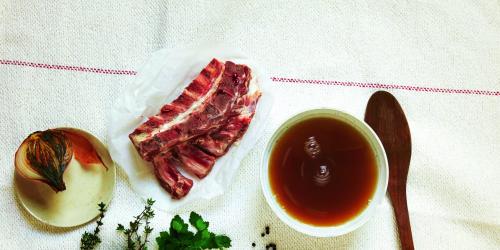Let's say everything is done to discourage us from eating meat. After the hormone-filled calf, the animal-meal cow and the antibiotic chicken, the lasagna scandal with fake beef but the real horse ... not to mention the surge in prices ( 24% in ten years), not surprising steak fans are tired or even worried. Between 1998 and 2009, meat purchases decreased by 7% in France.
Lower meat consumption: a blessing for the planet?
According to the UN Food and Agriculture Organization, livestock are responsible for 70% of deforestation, 18% of greenhouse gas emissions (more than all transport on the planet), and they consume 70% of the world's water (the production of 1 kg of beef requires 15,500 liters of water). The scientists gathered at the 2012 World Water Conference were formal: in 2050, we will be 9 billion, with no choice but to move to vegetarianism . Especially since the emerging regions have only one desire: to adopt our way of life and devour more and more steaks.
Meat: Nutritional assets ... also found elsewhere
Let's shell out the benefits of a rib of beef. Praised for its proteins , its iron and its vitamins of the group B , whose B12, is it the only possible source of proteins? No. It is found in fish, shellfish, dairy products, eggs, cereals and legumes. In addition, putting proteins in the center of our plate is exaggerated. They must represent only 15% of our diet.
Are they all identical? Nearly. They are composed of amino acids, eight of which are essential for our health. The latter are present, in all, in meat and fish, but also in soy and spirulina algae. Cereals and legumes are incompletely endowed: it lacks lysine in the first, and in the second sulfur-containing amino acids. This is not a problem, except in everyday life: preparing a vegetarian dinner takes more time and thought than serving a ham-pasta menu, but we're doing. Moreover, many countries already have their combination to get the right balance: couscous and chickpeas in the Maghreb, rice and lentils in India ... Meat would not be essential?
We can live without meat. But without animal protein? There, I am more reserved. If we totally deprive ourselves, like vegans, we end up with a program of life quite complex to follow.
nuance the nutritionist and doctor Arnaud Cocaul (author of "SAV diets").
Confirmation of another nutritionist, Nathalie Hutter-Lardeau (author of "Mince Alors!"): "To do without meat or animal proteins in general, is to become an expert.It is necessary to juggle the menus in order to find his rations of protein, iron and vitamins I am vigilant when I am asked for an animal protein-free diet for a child, a pregnant woman or an elderly person. "
Another advantage of meat is its high iron content. Since Popeye, we know that there are also in plants, such as spinach (not that much), spices (cumin, coriander, cinnamon ...), soy or seaweed. But not all are equal. That of animal origin, "hemic", is the most easily assimilated by the body: 10 to 30% of this iron ingested are effective. That of plant origin is only absorbed by 1 to 5%. A priori, to obtain his daily dose (14 mg), the simplest is the beautiful steak: "The more it is red, the more it is rich in heme iron , " notes Nathalie Hutter-Lardeau. However, offal (livers, kidneys) and seafood contain more: periwinkle contains twice as much as roast beef, clam, three times more.
We do not all have the same iron needs. A piece of black pudding every two weeks for the children is enough. On the other hand, women who lose 15 to 25 mg of iron a day at the time of menstruation must increase their intake.
Tips: Forcing on vitamin C (blackcurrant, parsley, raw peppers, citrus fruits, red fruits ...), which allows to better assimilate non-heme iron. And then 'pay attention to tea, especially green , which has a negative impact on the iron. Especially if you drink it during meals, " adds Dr. Cocaul. The remaining B vitamins, especially B12, are found only in meat, fish, milk and eggs. Recent studies show that Nori seaweed and spirulina contain some. And, according to nutritionists, vitamin B deficiencies are extremely rare.
Meat partly responsible for cancer and diabetes: the truth of fake
Meat would not promote coronary heart disease, type 2 diabetes, colon cancer? Beware of approximations. What is the relationship between pork belly, rich in saturated fatty acids (the worst), and a chicken breast, poor in everything except protein? The enemy would be rather red meat. And again, not all: a grilled steak is three times less fat than a steak cooked likewise. However, are the boldest red meats to be banned? No, it's a question of dosage. While keeping in mind that, consumed excessively (more than once a week), they promote overweight and, by extension, cardiovascular disease and diabetes.
Regarding cancer, it gets tough. According to the National Cancer Institute, "the excessive consumption of red meat (beef, mutton ...) and cold cuts (pork) is a risk factor for cancer of the colon and rectum" . But oncologist David Khayat does not believe it: "No study has shown it. "However, everyone agrees to suspect barbecuing, purveyor of polycyclic hydrocarbons and heterocyclic aromatic amines.
Would a diet without meat protect us from these evils? "Maybe ," says Dr. Cocaul, " according to an American study that compared Seventh-day Adventists, vegetarians, and Mormons, omnivores. The former had a lower rate of cancer, diabetes and coronary heart disease. "But unclear whether it rather comes from the diet or rigorous lifestyle, without excess.
When you exclude meat from your diet, it would be a shame not to eat fish. It is an interesting source of essential fatty acids (omega 3). Even if it is found in vegetable oils, but there is a change of calorie register: the oil is 100% fat.
says Nathalie Hutter-Lardeau.
Note that omega 3 is also found in oceanic algae.
The star of vegetarian diets is soy, in seeds, flour, oil, milk, yoghurt, tofu and sauce. With the full range of essential amino acids , soybeans contain almost twice as much protein (40%) as meat. But this rate falls in the products commonly used here: soymilk (3.5%) and tofu (9%). It also contains phytoestrogens (isoflavones), which can reduce hot flushes during menopause (a good point), but also disrupt the mechanism of lactation in breastfeeding women and promote the proliferation of tumors in menopause who have had breast cancer (two bad points).
The future of dried crickets and in vitro steaks to replace meat?
Do you prefer insects? The European Union has invested 3 million euros to replace meat and fish. Not tempted? It remains steak in vitro, in the research stage (we can only produce a few inches of muscle, which cost several thousand dollars) ...
Eliminating the meat from our menus is not for now. But it is a fact, we eat too much: before decreasing in recent years, our consumption tripled between 1900 and 1990. In our plate, 70% of proteins are of animal origin, whereas a century ago 70% came from plants. To find this balance, in the United Kingdom, Belgium and the Netherlands are organized days without meat. In Paris, school canteens in the 2nd arrondissement have introduced a "veggie" day a week.
Our cuisine is centered around meats in sauce: stew, beef with carrots ... And when you cook peas, it's with bacon. However, in the same way that we do not eat foie gras at every meal, it's time to put the soft pedal on the shallot bib and cook vegetables, seeds and cereals in our own way.
Find tonight on France 5 the documentary "A world without meat" at 20:40


